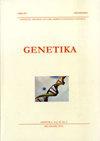著名自然风景区“阿瓦拉”的无梗栎(Quercus petaea (matt.) liebl)的遗传结构
4区 农林科学
Q3 Agricultural and Biological Sciences
引用次数: 1
摘要
本文介绍了杰出自然美地区无柄栎种群遗传多样性的分析结果。利用SSR标记获得的“阿瓦拉”。从两个群体的50棵试验树的叶片组织中分离出基因组DNA。采用微卫星标记QpZAG110、QpZAG15、QpZAG1/2、QpZAG3/64、QpZAG36、QpZAG1/5和QrZAG108进行基因分型。所有位点均具有多态性,PIC均值较高(0.934)。在所研究人群中测定的等位基因总数为127个。等位基因数量从15个(QpZAG1/5、QpZAG1/2)到23个(QpZAG110)不等,平均每个位点有18.14个等位基因。有效等位基因数为8.273个(QpZAG1/5) ~ 13.830个(QrZAG108)。基因流(Nm)均值为8.522,范围为5.548 ~ 14.876。总体遗传多样性高(He = 0.909),范围为0.879 ~ 0.928。由于在大多数位点上观察到过量的纯合子,检测到显著的近交系数(Fis = 0.796)。分子方差分析(AMOVA)证实群体内(77.5%)的遗传多样性高于群体间(1.6%)的遗传多样性。研究群体的平均等位基因频率(Q)表明个体来源于两个或两个以上的群体。所获得的结果可用于制定适当的计划来管理受保护的自然资源和管理这一生态和经济上重要的树种。研究结果为采用原位和非原位方法保护无根栎遗传资源提供了依据。根据研究结果,可以推荐在最佳小气候条件下重新引入这一重要物种,并选择最佳的重新引入个体。本文章由计算机程序翻译,如有差异,请以英文原文为准。
Genetic structure of Sessil oak (Quercus petraea (matt.) liebl) from the area of outstanding natural beauty “Avala“
The paper presents the results of the genetic diversity analysis of Sessile oak populations from the area of outstanding natural beauty (AONB) "Avala" which were obtained using SSR markers. Genomic DNA was isolated from leaf tissue of 50 test trees from two populations. Genotyping was performed using microsatellite markers QpZAG110, QpZAG15, QpZAG1/2, QpZAG3/64, QpZAG36, QpZAG1/5, and QrZAG108. All loci were polymorphic with the high mean value of PIC (0.934). The total number of alleles determined in the studied population was 127. The range of alleles varies from 15 (QpZAG1/5, QpZAG1/2) to 23 (QpZAG110) with an average of 18.14 alleles per locus. The number of effective alleles ranges from 8.273 (QpZAG1/5) to 13.830 (QrZAG108). The mean value of the gene flow (Nm) was 8.522 with a range from 5.548 to 14.876. Overall genetic diversity was high (He = 0.909) and ranged from 0.879 to 0.928. Due to the excess of homozygotes observed at most loci, a significant inbreeding coefficient was detected (Fis = 0.796). The Analysis of Molecular Variance (AMOVA) confirmed that genetic diversity was more pronounced within populations (77.5%) than between them (1.6%). The average allele frequency (Q) of the studied populations shows that the individuals originate from two or more populations. The obtained results can be used for the adoption of appropriate plans for the management of protected natural resources and the management of this ecologically and economically important tree species. Also, the obtained results enable the adoption of the necessary measures for the conservation of sessile oak genetic resources by in-situ and ex-situ methods. Based on the research results, the use of this important species can be recommended for its reintroduction in optimal microclimatic conditions, as well as in the selection of the best individuals for the reintroduction.
求助全文
通过发布文献求助,成功后即可免费获取论文全文。
去求助
来源期刊

Genetika-Belgrade
AGRONOMY-GENETICS & HEREDITY
CiteScore
1.80
自引率
0.00%
发文量
1
审稿时长
6-12 weeks
期刊介绍:
The GENETIKA is dedicated to genetic studies of all organisms including genetics of microorganisms, plant genetics, animal genetics, human genetics, molecular genetics, genomics, functional genomics, plant and animal breeding, population and evolutionary genetics, mutagenesis and genotoxicology and biotechnology.
 求助内容:
求助内容: 应助结果提醒方式:
应助结果提醒方式:


